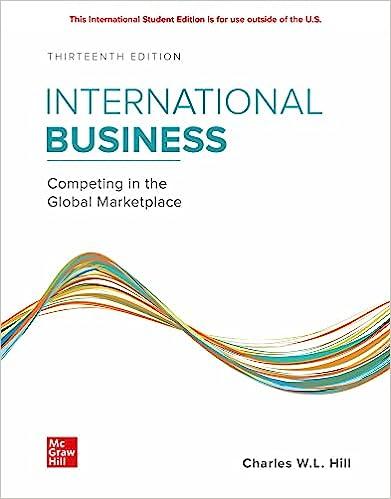Tata Motors Limited (tatamotors.com) was formerly called TELCO, an abbreviation for Tata Engineering and Locomotive Company. Today,
Question:
Tata Motors Limited (tatamotors.com) was formerly called TELCO, an abbreviation for Tata Engineering and Locomotive Company. Today, Tata Motors is an Indian multinational automotive company headquartered in Mumbai and a core member of the very successful Tata Group. The Tata Group was founded in 1868 and has annual sales of more than 105 billion USD, of which Tata Motors makes up about INR (Indian rupees) 262,796 crores, or about 42 billion USD. Tata Motors has more than 60,000 employees, was founded in 1945, and serves a worldwide clientele with Tata Motors Cars, Jaguar Land Rover, Tata Daewoo, and Tata Hispano. The company entered the passenger vehicle market in 1991 with the launch of the model Tata Sierra (a three-door sport utility vehicle).
Tata Motors thrives in exporting, strategically using it as a global vector to sell cars worldwide, as well as to help offset cyclical tendencies in sales in its home market of India. Tata Motors exported about 55,000 commercial vehicles last year and plans to export 100,000 commercial units within the next two years. The target for the increase in exporting is everywhere worldwide, except in Europe and North America. The global strategy for Tata Motors specifically includes making deeper inroads into the Middle East, Africa, and Latin America.
As the fourth-largest bus manufacturer globally, Tata Motors provides innovatively designed and technologically sophisticated buses for the smart cities of tomorrow. The buses personify safety and comfort, reliability, and profitability.
Designed using the most advanced technology, Tata Motors’ bus chassis are a benchmark in terms of performance and reliability in the bus industry. Fully finished, built buses from Tata Motors are often viewed as a hallmark of excellence, and these buses have been designed with the utmost quality standards in mind.
Tata Motors exports buses and trucks to nearly 47 countries, including Russia, 18 countries in Africa, four markets in Latin America, and various countries in Europe, the Middle East, and the Asia Pacific region. Some of the popular vehicles exported include the company’s globally benchmarked range of Prima and Ultra autos. These brands have been developed with modern design and global markets in mind. Tata Motors also exports a variety of premium buses and coaches, from luxurious intercity travel vehicles to safe choices for the transportation of elementary school children. The buses come in 12 seaters to 67 seaters. Additionally, in the pickup and small commercial vehicle (SCV) segments, Xenon XT and Super Ace have been popular choices in many countries.
Future exporting activities for Tata Motors are mainly planned to target an increased presence in emerging countries (e.g., Africa, Asia Pacific, Middle Eastern, and Latin America). The company is placing its global bets on world-class products like the Xenon, Super Ace, Prima, and Ultra range of trucks. The overall exporting goal is to continue entering new markets and to keep expanding the global footprint of Tata Motors.
Questions
1. How can Tata Motors use their core competencies in doing well in India as a way to also do well in exporting?
2. Jaguar Land Rover Automotive PLC is the holding company of Jaguar Land Rover Limited, a British automotive company which has its headquarters in the United Kingdom. It is also subsidiary of Indian automotive company Tata Motors. How can Tata Motors leverage Jaguar Land Rover in its exporting? How can Jaguar Land Rover leverage Tata Motors in its exporting?
3. The Volvo Group is a manufacturer of trucks, buses, and construction equipment, which is owned by Swedish interests. Volvo Car Corporation or Volvo Cars, on the other hand, is owned by the Zhejiang Geely Holding Group (it was formerly owned by Ford Motor Company). Because they are already successful in much of the world market, should Tata Motors use this Volvo Group example and focus more, or even exclusively on, buses and trucks in its exporting?
4. Tata Motors is primarily targeting emerging countries (e.g., Africa, Asia Pacific, Middle Eastern, and Latin America) for its future export growth. Is this a viable and logical export strategy?
Step by Step Answer:

ISE International Business Competing In The Global Marketplace
ISBN: 9781260575866
13th International Edition
Authors: Charles Hill





